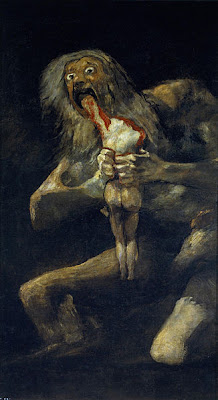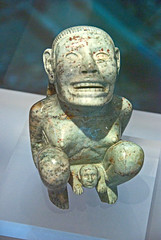"Methinks, brother, replied my father, you might, at least, know so much as the right end of a woman from the wrong . . . . Right end of a woman! — I declare, quoth my uncle, I know no more which it is than the man in the moon!"
- Laurence Sterne, "The Life and Opinions of Tristram Shandy, Gent." (Bk.I, ch. XXXII)
In the age of social networks, when women stream live videos of their home deliveries on Facebook, share sonograms, breast feeding tips and cervical dilation data to the millimeter (mm), it's entirely likely that you may happen upon the "wrong end of a woman" while surfing the Internet or the wilderness that is cable. Marni Kotak has just upped the ante for overshare. Kotak is a performance artist who intends to give birth before an audience on the stage of a Brooklyn art museum.
(Probably should have had it in the woods)
I have no particular difficulties with this intended act of public spawning - after all, it seemed an inevitability, given our cultural impetus towards the sort of personal "transparency" that too often collapses into vapidity. And you can attend or not, depending on your interest and whether the event corresponds with one of the lacunae on your astrological, lunar or standard (Gregorian) social calendar. If it turns out that you can make it, I'm sure it was meant to be.
Her motives, whether narcissistic or gender-empowering, don't pique my interest so much as her rationale for choosing to make the birth a public spectacle. It is, she claims, an artistic moment: “Giving birth is the most direct expression of the creative life force, and, therefore, the highest form of art. By giving birth in public as a work of performance art, I am making the statement that everyday life is art, just as it is.”
These two sentences bear some scrutiny, the first being incomprehensible and the second being just wrongheaded. For starters, the idea of a "creative life force" has the ring of profundity and spiritual gravitas that masks its lack of any sense. It's fun to confer ontological ballast onto our grand words and overheated phrases, but aside from a world of living breathing creatures all capable of doing animal things like procreating, we'd look long and hard for something else besides - a "life force" driving all these acts of creation here in the sublunar dirt. As though one were to watch all the whirls and frolics of a dancing child and then wonder, "But where's its 'dance'?"
Furthermore, "Everyday life" is not art - it's what the garbageman does while riding the garbage truck, what the clerk at the convenience store does while ringing up your corndog, what the janitor does when the office has cleared out for the day. I'm not saying these things can't be done artfully, with a certain individual panache, with a sense of style or flair or joie de vivre or personal elegance, but they're just not art. Even things that can be done artistically, like applying makeup or dressing store windows or hanging draperies, aren't art - to claim that they are is to allow too broadly, to permit that even the cheesy drapings of the workmanlike Christo comprise art, which is plausibly open to dispute.
Art about art
Art, even "realist" art, necessarily involves artifice. It can represent the world as it appears, someone's perception of the world, a sentiment about the world. Art is intentional in the sense that artistic works necessarily have an object (even if no more substantial than a psychic state) - something beyond the artistic object which gets expressed in some act of representation. It's also intentional in the sense that it's deliberate. Giving birth (beyond some indefinite point at which natural process is no longer choice) becomes biological inevitability, neither intentional nor unintentional. (This has no bearing on whether an "artist's intentions" are relevant to judging a work.)
But giving birth in public is just giving birth in public - just that and no more. It isn't the "direct expression" of anything at all - no more than a phallus is a "phallic symbol." It may be wonderful for all concerned, but it isn't a "performance" of something else, it neither expresses nor represents something beyond itself nor transcends everyday living to say anything about anything.
Art about life
In short, everyday living isn't art, and childbirth is part of everyday living for many of us carbon-based types. A counterexample here may be both helpful and fun. Suppose that some "artist," humbly obscure or otherwise, decides that his loo is now his studio, and begins to take commissions on his output. Does that make him an artist? or transform his performance of an everyday and inevitable function, however beneficial to himself or advantageous to the larger society, into "Art"?
The answer by now should be at least as clear as mud.




No comments:
Post a Comment